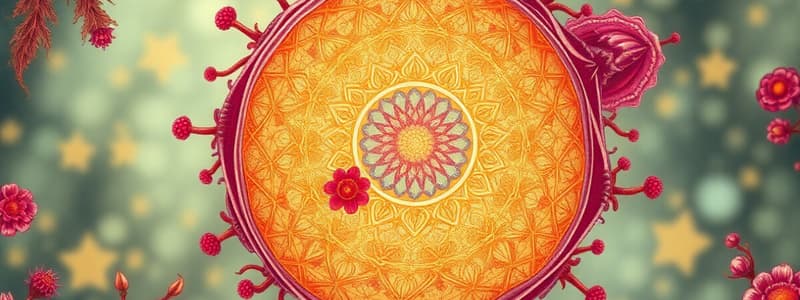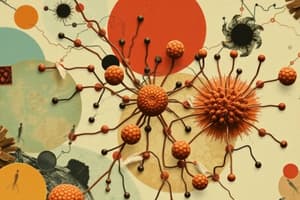Podcast
Questions and Answers
What is the process by which plants convert sunlight into glucose?
What is the process by which plants convert sunlight into glucose?
- Photosynthesis (correct)
- Fermentation
- Cellular Respiration
- Transpiration
Which body system is primarily responsible for transporting oxygen and nutrients throughout the body?
Which body system is primarily responsible for transporting oxygen and nutrients throughout the body?
- Digestive System
- Circulatory System (correct)
- Respiratory System
- Endocrine System
What is the primary role of a vacuole in a cell?
What is the primary role of a vacuole in a cell?
- To provide structure
- To synthesize proteins
- To store water and nutrients (correct)
- To control what enters/exits the cell
Which of the following is true about the levels of organization in biological systems?
Which of the following is true about the levels of organization in biological systems?
What is the equation for cellular respiration?
What is the equation for cellular respiration?
Which characteristic of life involves reacting to changes in the environment?
Which characteristic of life involves reacting to changes in the environment?
What is a primary distinction between prokaryotic and eukaryotic cells?
What is a primary distinction between prokaryotic and eukaryotic cells?
Which statement best describes the Cell Theory?
Which statement best describes the Cell Theory?
Which of the following is a biotic factor?
Which of the following is a biotic factor?
What is the main function of mitochondria in a cell?
What is the main function of mitochondria in a cell?
Which statement about the characteristics of life is incorrect?
Which statement about the characteristics of life is incorrect?
Which structure is responsible for controlling cellular activities and housing genetic material?
Which structure is responsible for controlling cellular activities and housing genetic material?
Which of the following statements is true regarding eukaryotic cells?
Which of the following statements is true regarding eukaryotic cells?
Study Notes
Characteristics of Life
- Living organisms are made up of cells, either single-celled (unicellular) or multi-celled (multicellular).
- Living organisms grow and develop, increasing in size and complexity over time.
- Living things reproduce, either sexually or asexually, to create new offspring.
- Organisms need to use energy to survive: some make their own food (autotrophs), while others consume it (heterotrophs).
- Living organisms react to changes in their environment, known as stimuli.
- Living things maintain a stable internal environment, a process called homeostasis.
- All living things have a genetic code, stored in DNA, which is passed down to offspring.
- Over time, living things can adapt to their environment, making them better suited to survive and reproduce.
The Cell Theory
- The Cell Theory is a foundational principle in biology.
- All living things are composed of cells, either single-celled or multi-celled organisms.
- Cells serve as the basic structural and functional units of organisms.
- All cells arise from pre-existing cells, meaning they don't appear spontaneously.
Abiotic vs. Biotic Factors
- Biotic factors are all living things within an environment, including animals, plants, fungi, bacteria, and viruses.
- Abiotic factors are non-living components of an environment, such as water, sunlight, temperature, soil, and rocks.
Cell Types (Prokaryotic vs. Eukaryotic)
- Prokaryotic cells lack a true nucleus, meaning their DNA is not enclosed by a membrane.
- Prokaryotes lack membrane-bound organelles, though they have ribosomes.
- Prokaryotic cells are generally smaller and simpler in structure than eukaryotic cells.
- All prokaryotes are unicellular, meaning they exist as single-celled organisms.
- Examples of prokaryotes include bacteria and archaea.
- Eukaryotic cells have a true nucleus, where their DNA is enclosed by a membrane.
- These cells contain membrane-bound organelles, like mitochondria, chloroplasts (in plants), and the endoplasmic reticulum.
- Eukaryotic cells are larger and more complex than prokaryotes.
- Eukaryotes can be either single-celled, such as protists, or multi-celled, like animals and plants.
Cell Organelles
- The nucleus is the control center of a cell, containing the genetic material (DNA).
- Mitochondria are the powerhouses of the cell, converting food into energy (ATP) through cellular respiration.
- Chloroplasts are found in plant cells and are responsible for photosynthesis, using sunlight to make glucose.
- Ribosomes are responsible for protein synthesis.
- The cell membrane acts as a barrier, regulating what enters and exits the cell.
- The cell wall provides structural support and protection to plant cells.
- Vacuoles store water and nutrients, playing a vital role in plant cell turgor pressure.
Cell Processes
- Diffusion is the movement of molecules from an area of high concentration to an area of low concentration.
- Osmosis is a specific type of diffusion where water moves across a semi-permeable membrane from an area of high water concentration to an area of low water concentration.
- Photosynthesis is the process by which plants use sunlight, carbon dioxide (CO2), and water to create glucose (sugar) and release oxygen (O2). The overall equation for photosynthesis is: 6CO2 + 6H2O → C6H12O6 + 6O2.
- Cellular Respiration is the process by which cells break down glucose to generate energy (ATP) in the form of adenosine triphosphate. The overall equation for cellular respiration is: C6H12O6 + 6O2 → 6CO2 + 6H2O + ATP
Levels of Organization
- The organization of life progresses from the simplest level, cells, to increasingly complex levels, culminating in a complete organism.
- This hierarchical structure is defined as follows:
-
Cells: The basic building blocks of all living things.
-
Tissues: Groups of similar cells that perform a specific function (e.g., muscle tissue, nervous tissue).
-
Organs: Structures composed of different tissues working together for a common purpose (e.g., heart, lungs).
-
Organ Systems: Groups of organs that cooperate to perform a major bodily function (e.g., the circulatory system, the digestive system).
-
Organism: A complete living being made up of interacting organ systems.
-
Example: Lung cell → Lung tissue → Lung → Respiratory system → Human
-
Tissues
- Muscle Tissue: This tissue is specialized for movement and contraction. There are three types:
- Skeletal Muscle: Attached to bones, responsible for voluntary movements.
- Smooth Muscle: Found in the walls of organs and blood vessels, responsible for involuntary movements.
- Cardiac Muscle: Found only in the heart, responsible for the heart's contractions, causing blood circulation.
- Connective Tissue: Provides support, binds, and connects different tissues and organs in the body. Some examples include:
- Bone: Provides structural support and protection, houses bone marrow.
- Blood: Transports oxygen and nutrients, fights infections.
- Nervous Tissue: This tissue is specialized for the transmission of signals and information throughout the body. The nervous system is responsible for receiving sensory input, integrating information, and generating motor output.
Body Systems
- Circulatory System: Transports oxygen, nutrients, and hormones throughout the body. Key organs include the heart, blood vessels (arteries, veins, and capillaries).
- Respiratory System: Responsible for gas exchange, taking in oxygen and releasing carbon dioxide. Key organs include the lungs, trachea (windpipe), bronchi, and bronchioles.
- Digestive System: Breaks down food into smaller molecules that can be absorbed by the body for energy and nutrients. Key organs include the mouth, pharynx (throat), esophagus, stomach, small intestine, large intestine, pancreas, liver, and gallbladder.
- Excretory System: Removes waste products and helps regulate water balance. Key organs include the kidneys, bladder, ureters, and urethra.
- Nervous System: Controls all body responses and activities. Key organs include the brain, spinal cord, nerves, and sensory organs.
- Muscular System: Allows movement, locomotion, and maintains posture. Key organs include skeletal muscles.
- Skeletal System: Provides structure, support, and protection for the body, produces blood cells. Key organs include bones, cartilage, ligaments, and tendons.
- Endocrine System: Regulates body functions through the production and secretion of hormones. Key organs include the pituitary gland, thyroid gland, parathyroid glands, adrenal glands, pancreas, ovaries (in females), and testes (in males).
- Immune/Lymphatic System: Defends the body against pathogens and diseases. Key organs include lymph nodes, spleen, thymus gland, and bone marrow.
- Reproductive System: Produces offspring. Key organs include ovaries, uterus, fallopian tubes, vagina (in females), testes, epididymis, vas deferens, prostate gland, and penis (in males).
Studying That Suits You
Use AI to generate personalized quizzes and flashcards to suit your learning preferences.
Related Documents
Description
Explore the fundamental traits that define living organisms and the core principles of cell theory. This quiz covers essential concepts such as cellular structure, reproduction, metabolism, stimuli response, homeostasis, and genetic inheritance. Test your understanding of how life is characterized and the role of cells in living organisms.




